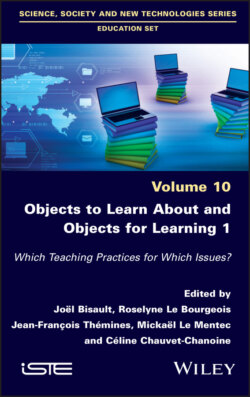Читать книгу Objects to Learn about and Objects for Learning 1 - Группа авторов - Страница 11
Part 1 of Volume 1 – Objects and Language(s)
ОглавлениеThis first part focuses on the relationships between objects in the broad sense and language(s): the learning, for young pupils, of foreign languages or the production of written work in French but also, for 12th grade students, the approach to the role of a “geometric object” in physics. Chapters mentioned in this part are concerned with clarifying, analyzing and investigating the mediation of a variety of objects and its contribution according to the learning objectives.
Progressing to writing short texts is a difficult step for the first grade pupils in a Zone d’éducation prioritaire (ZEP) 4. The objects chosen to tell a story materialize the elements and characters of the plot, thus becoming “catalysts” for writing. “The objects, through their materiality and the actions they stimulate, give a real character to situations that the child struggles to represent to him/herself because it calls for such a high level of abstraction” (written by Bruno Hubert in Chapter 2).
Chapters 1, 3 and 4 of Volume 1 examine foreign languages: second languages (Chapters 1 and 4) and additional languages (Chapter 3), respectively.
Chapter 1 (Élise Ouvrard) investigates the contribution of work carried out around children’s English-language picture books and their handling in Modern Foreign Languages (MFLs) sessions in elementary cycle 3, and considers what their instrumentation may involve. It compares approaches of beginners and experts in order to analyze the entries into reading enabled by these approaches, and underlines what is gained through material contact with these picture books: an affective environment and an emotive learning experience. It is an invitation to training so that the introduction of these books can become a real entry into foreign language literacy.
The Content and Language Integrated Learning (CLIL) experience (Zebra Gabillon and Rodica Ailincai in Chapter 3) lies at the intersection of the socio-cultural and the (socio-)interactionist perspectives. The two perspectives allow us to consider the role of mediation in language development, together with the role of linguistic and communicational aspects in the learning process. The joint contribution of the two teacher–researchers is innovative and offers the particularity of reporting on research on the CLIL process implemented in English, at elementary level, in French Polynesia. Chapter 4 (Émilie Magnat and Karima Olechny) offers a reflective study of objects for language in kindergarten and the process which probationary teachers pass through with regard to the use of these objects, with a view to raising English language awareness. The choice of learning objects used (sequential images from a children’s story, a felt mitten, wooden characters) and the preferred approaches underline the importance of training so that objects and processes become instruments for linguistic development.
Finally, in Chapter 5 (Laurent Moutet), the term “language” refers not to French or to another national language, but to a different semiotic system: graphic language. This graphic language, which makes it possible to visualize a mathematical relationship between the quantities of the system being studied, plays a very important role in scientific and technological education, particularly for the content and the school level being considered here (special relativity in a 12th grade science major). The graphic that is constructed with the pupils and then used (Minkowski diagram) takes on the status of a “graphic object” that enables the pupils to reason on concepts that are often counterintuitive. This chapter thus illustrates the fundamental role played by graphic representations in conceptualization.
